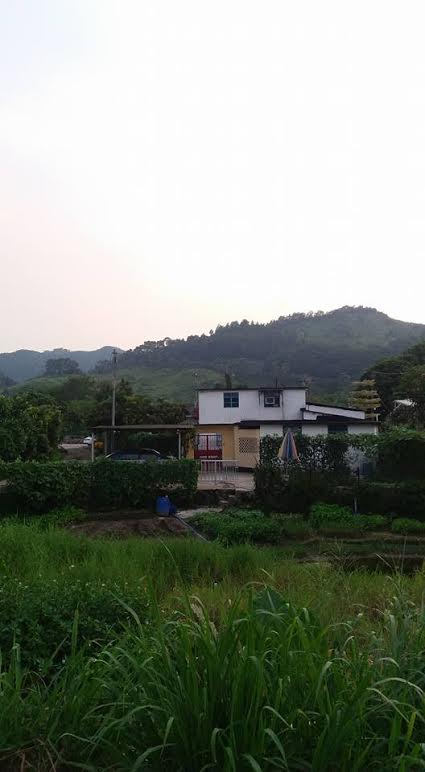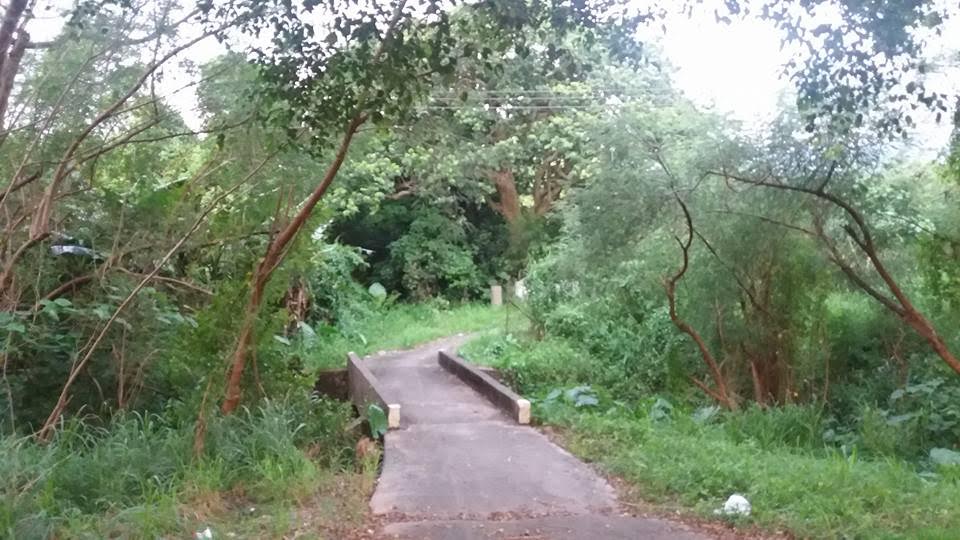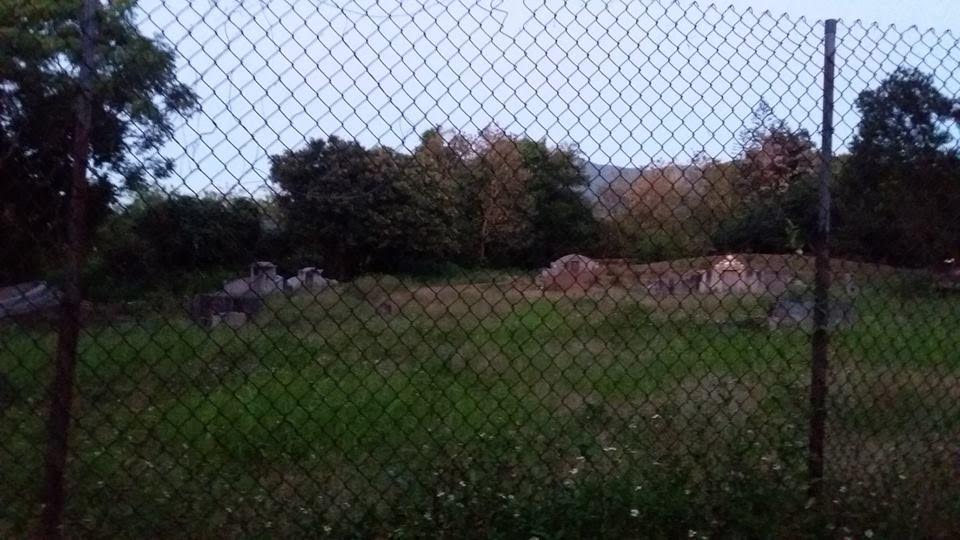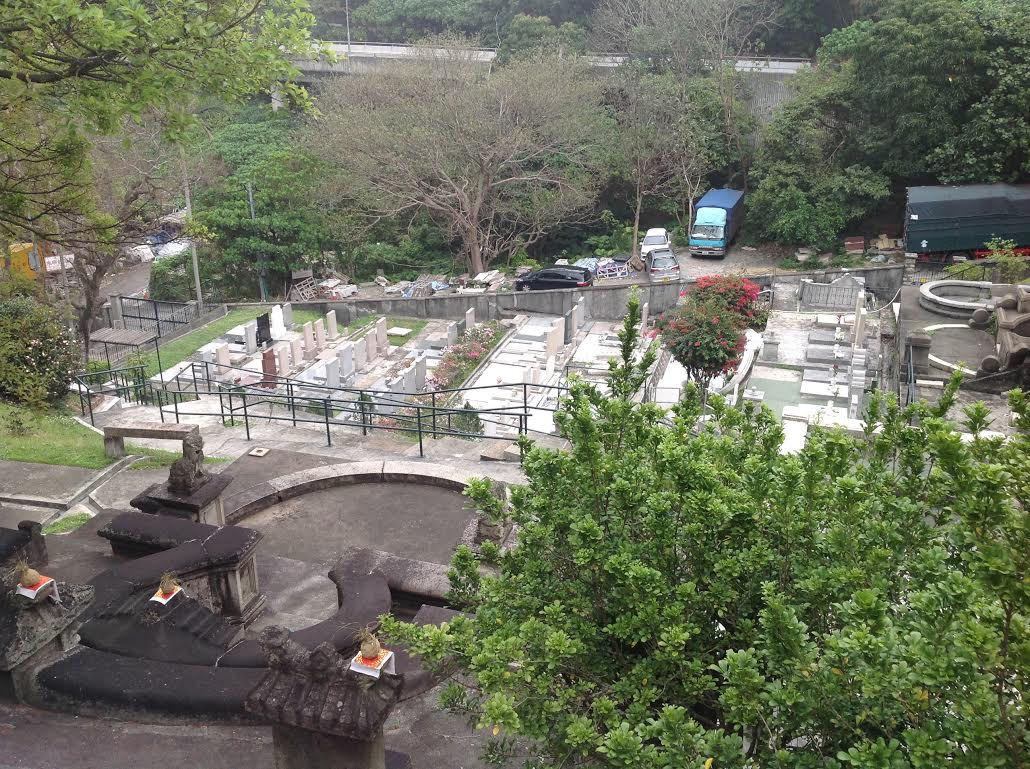I always preferred to walk to Emi’s house rather than take the bus.
Getting off at the Kam Sheung Road MTR station in Yuen Long, I’d trek past the encampment of fruit, snacks, and goods stalls, avoid getting hit by a green and yellow mini bus screeching to a halt at the terminal, and cross Kam Sheung Road when the pedestrian light would finally change. A few times it skipped me altogether, and my palms would get a little sweatier (no small thing in the relentless humidity of Hong Kong) as I’d run across the street in front of the underpass.
 Emi and her roommate Jay often asked me why I insisted on walking to their village flat instead of taking the quick, air-conditioned bus. Their neighborhood in Yuen Long, being outside of the city, in Hong Kong’s New Territories, was rather rural, full of bugs, and devoid of the usual lights and shops that people think of when they think of the glittering metropolis that is Hong Kong proper.
Emi and her roommate Jay often asked me why I insisted on walking to their village flat instead of taking the quick, air-conditioned bus. Their neighborhood in Yuen Long, being outside of the city, in Hong Kong’s New Territories, was rather rural, full of bugs, and devoid of the usual lights and shops that people think of when they think of the glittering metropolis that is Hong Kong proper.
The few shops and businesses that dotted the the main road were auto salvage type places strewn with car parts and lazy “guard dogs”, little village shops that sold snacks, drinks, and cigarettes, and textile manufacturers or warehouses. Push a little further into one of the village enclaves and you might find tiny restaurants (there was a pizza parlor!), a pet shop, food stands, but all rather quiet and charming – but unassuming.
If you knew what you were looking for, there was a pet crematory that looked like a public restroom from the outside. The inside was actually quite warm and professional, like a Chinese grandma had decorated it. My cat had been cremated there.
But I liked the walk because it took me through part of a Yuen Long village. More specifically the graves of that village.
Crossing Kam Sheung Road I’d walk up to the river and hang a right, taking the road along the outskirts of the village. Trees shaded the street overhead, and all around me the concrete of Hong Kong was taken over by green mountains in the distance, dense plants, and overgrowth. I was constantly on the lookout for low-hanging spiders.
After about 10 minutes I’d get to the short, stone bridge that led off the street into Emi’s part of the neighborhood. The greenery became more claustrophobic, the bugs buzzed more aggressively in your ear, and the road became a rutted mix of asphalt, rocks, and earth.
The first graves stood around the bend, right after you crossed the bridge. Large, U-shaped Chinese graves, one with what appeared to be shiny metallic adornment at the top. The two largest ones, set against a mound, were probably about as tall as my five-foot-four inches at their apex. Three other smaller graves, also U-shaped were scattered about the field too.
The graves, like a little grave-family, sat in a field that was sometimes overgrown, sometimes cut down, with rocky patches poking through. There didn’t appear to be a rhyme or reason in the placement of the graves to my westernized eyes. They looked scattered but quite cozy in the field, protected from curious passersby (like myself) by a warped, rusty chain link fence.
It was hard to see if the random-seeming graves belonged to a home or the nearby temple. If anything, they seemed feral; like a band of nomadic graves that had decided that that field was a good place to plant themselves.
SOMEONE tended to them now and again, SOMEONE occasionally placed incense. It was a mystery I was happy to be a passive observer of, just grateful that I got to say hello from time to time.
I’d continue down the curved, bumpy road past a high, red wall with gold Chinese characters on it. In showing a picture to my mom – who can actually read Chinese, unlike me who is sadly illiterate in my family’s mother tongue – she said that it was a Buddhist temple, and that just seeing some part of the writing on that red was was supposed to be good luck. I wonder if this temple had something to do with the graves in the area?
Smaller graves popped up on either side of the road as I continued to Emi’s.
To the left, off of what looked like a driveway canopied in trees, was a tiny headstone that jutted out at an odd angle. It looked like it might have had abbreviated, sloping, U-shaped arms at one point – a micro version of the graves in the field – but its placement over tree roots had long since crumbled the architecture.
Other relatively small, conservative graves would pop up here and there in fields or peeking out of overgrown grass and plants at a fork in the road. Some looked forgotten, some might have only been masquerading as forgotten. I can’t be sure, but I suspect many of these graves were illegal.
As one of the most crowded places on earth, space for the living in Hong Kong, let alone the dead, is scarce.
In Yuen Long specifically, there has been tension between the government and the indigenous people. While people are supposed to get permission create a burial ground or dig a grave, the lack of land availability (and frankly, the government’s lack of attention to the matter) has led many illegal graves and cemeteries to pop up in the more remote New Territories.
In parks, on small farm plots, the middle of wooded areas – discovering the odd grave in rural Hong Kong was not actually that odd. While hiking through a park that surrounded a reservoir in New Territories, I spied a handful of graves on the hillside and hidden amongst the trees. A couple were huge, hulking Chinese graves whose arms easily reached 20 feet across and six to eight feet tall. While these larger ones may have been legal, belonging to old families in the community, the smaller, more discrete ones probably were not.
But with long wait lists for the enormous multi-level cemeteries in Happy Valley or on Mount Davis, even for one of the city’s many columbaria, many Hong Kongers have taken to burying where they can.
My favorite grave on my “grave walk” through Emi’s village was a medium-sized Chinese grave that was all but toppling into a ditch. Situated right next to where it seemed the neighborhood set out their recycling, the grave sat slanting on a triangular patch of grass and dirt just a few feet off the side of the road.
It looked like the ground on one side of it had collapsed, creating a shallow trench. Yet the grave obstinately clung on, remaining intact.
Its headstone was about chest high on me, with it’s short arms stubbornly holding onto the earth, reaching about four feet across at its widest. While it appeared that someone was lackadaisically clearing it of debris from time to time, it looked largely unkempt; rogue recycling and dead plants would often all but obscure it.
I liked that grave. It looked like it had no business being there, yet it refused to budge. It was scrappy. It was like saying hello to a friend every time I walked by.
But one evening in early spring my friends got a makeover.
You see, Hong Kong cemeteries had sprung to life for Ching Ming or the Grave Sweeping Festival. During this time of year, in the third month of the lunar calendar (typically around April 5th, this year it’s April 4th), Chinese people in China, Hong Kong, Taiwan, and Macau among other places take to graves and tombs to clean them up. It is the first of two Grave Sweeping festivals, the other being Chung Yeung in the fall.
During Ching Ming graves are cleaned and tended to, but more than that, ancestors are honored and respected.
I remember passing by a cluster of random-seeming graves near a roundabout in Yuen Long. Situated on a hill, Chinese and western style graves dotted the terrain. I suspect this was one of the more official burial grounds.
Families carefully cleaned up the graves with intensity and focus. One woman scrubbed a headstone with a rag, another cleared weeds. Smoke filled the air as incense and paper “Hell money” (a translation not indicative necessarily of the Christian Hell), paper clothes, paper food and drink, even paper cell phones were burned so the dead could use them in the afterlife.
Side query: Who do the dead call? What if they want to call another dead person but that person’s family wasn’t considerate enough to burn a phone for them? What if that family burned them a shoddy flip phone, and that dead person’s best pal wants to send them a hilarious video of a ghost kitten? What is the afterlife without hilarious cat videos? One can only hope that the flip phone ghost’s family also burned a paper iPad for them.
There are entire shops in Hong Kong devoted to the sale of burnable paper goods for the dead. You all can burn a paper TV (with paper Netflix) for me someday, with a six pack of paper San Miguel beer and a paper pizza.
Food (real not paper) is offered too. Loved ones will bring entire feasts to graves, complete with wine. The point is to let the dead know that they have not been forgotten, and to make sure that they have everything they might need in the afterlife. To believers, not doing so is asking for retribution from the dead. This is Chinese after-death care.
Along with the Hungry Ghost Festival in late summer and Chung Yeung in the fall, I loved Hong Kong’s commitment to remembering the dead. I loved the way death and the dead were never permitted to be forgotten. A few times a year the dead were brought to the forefront. Either because the air would be thick with incense and burnt offerings (my urban street in the neighborhood of Jordan would be foggy with smoke during the Hungry Ghost Festival), or because your friendly neighborhood graves would come to life – one would be hard-pressed not to let the dead cross your mind.
Death, the dead, and how we regard them was never far from the cultural conversation.
But back to my friends.
During that early spring evening, I was walking to Emi’s wondering if I should have brought two bottles of wine instead of one for the group that was gathering, when after crossing the stone bridge, the family of graves caught my eye.
Someone had tidied them up (they were almost gleaming), cut the grass around the graves, and flecks of light from burning incense by the headstones glowed in the pink Hong Kong twilight. I always loved how Hong Kong turned pink, or sometimes blue, as night fell.
Adorning the graves were flowers, remnants of brightly colored paper, some fruit, and piles of ash. The family looked all dressed up.
Down the road my favorite grave looked like the belle of the ball. If the ball was in an overgrown ditch. But who’s judging? Like I said, that grave was scrappy.
The overgrowth had been cleared from the grave, and its marble headstone was actually reflective and clear of candy wrappers. While its arms sagged, you could actually see the gray-pink in the stone, and the formerly dirt-caked words carved into it were crisp and clear. It was like the old gal got a facial.
Incense glowed at the grave’s base, next to a full, fresh beer bottle and a soft drink can. A little glass container of clean water sat a little ways away from the beverages.
Seeing this leaning grave looking so cared for sparked a surprising amount of emotion in me. I couldn’t stop from smiling, and as I stood alone, creepily grinning at a grave at the side of the road in the near-dark, a lump grew in my throat.
I didn’t know this dead person, I didn’t have any real connection to this grave other than the fact that I liked it, and had anthropomorphized it into this weird, tough, lady-grave who HAD SEEN SOME THINGS, I TELL YOU WHAT.
But I was delighted to see her – I’ve been resisting calling the grave “her” this whole time, but WHATEVER, we’re past any professional distance at this point – getting some care. She wasn’t forgotten.
Whoever was buried in that grave, Ching Ming had given their loved ones cause to think of them and attend to them (even if out of duty). That dead person was important a few times a year.
And who knows, maybe that off-kilter roadside grave had more fans than just myself? Maybe that neighborhood grave was just one of several fond reminders of mortality for the community?
I know that those random Yuen Long graves are probably not long for Hong Kong. Eventually the argument that people can’t just bury their dead where they feel like it will be won, and the those village graves will either be exhumed and moved, leveled, or left to crumble. The graves will die too.
But until then the graves, not sequestered away in some gated cemetery or remote graveyard, are a normal part of life in Yuen Long. Amidst the growing number of modern apartments that are overtaking the low, squat houses and boxy, two-story village homes, lie a scattering of tenacious graves that don’t actually seem out of place. Life and death mingle quite nicely.
When I would be walking to Emi’s, feeling more alive than ever, there was a peacefulness in encountering those graves. Maybe the people interred, my “friends”, had walked the same path I had; had even noticed some of the same graves I noticed?
On those quiet solo walks, the dead of Yuen Long became an important and precious part of my life, and it was an honor to remember them.
Louise Hung is an American writer living in Japan. You may remember her from xoJane’s Creepy Corner, Global Comment, or from one of her many articles on death, folklore, or cats floating around the Internet. Follow her on Twitter.




